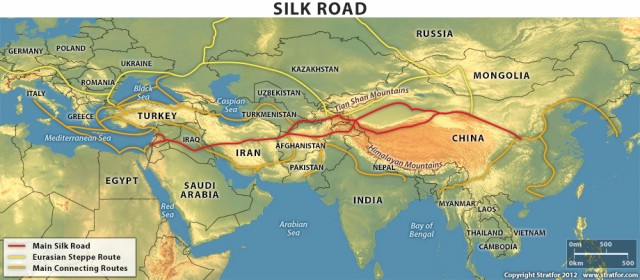Silk Road
BETWEEN MESOPOTAMIA and CHINA stretched Central Asia, large, barren, hostile—a wasteland. Through this vast area, the one link that allowed the two civilizations to trade with each other was the loosely defined cluster of trails known as the Silk Road. Even today, the Silk Road runs through one of the harshest desert environments in the world, with little water or vegetation or life. It is sandy, and sandstorms bury everything in their way. The local inhabitants refer to the Taklimakan Desert as “the Land of Irrevocable Death.” Locals stayed near the Silk Road and the other paths around the edge of the desert.
Northeast of the Taklimakan is the GOBI DESERT, less desolate and dry, but still formidable. To the south are the HIMALAYAs, Karakourum, and Kunkun, the highest mountain ranges in the world. Another barrier between west and east is the PAMIR KNOT, several mountain ranges. including the TIAN SHAN and Pamir. The easiest access from the east is by the comparatively fertile Gansu Corridor, which lies between the Tibetan High Plateau and the Gobi Desert and Mongolian plateau. Travelers from the south had to cross ice-laden passes in the Himalayas and the Pamir Knot.

China and Mesopotamia developed civilization and commerce, Mesopotamia first, with China developing later because the terrain was more difficult. The Qin Dynasty established a central government for the individual states. The capital was at Changan (presentday Xian). The Han Dynasty first explored to the west, when Zhang Qian sought to ally with the Yuezhi tribe in the west. The 13-year journey began in 138 B.C.E. He returned with no ally but with information about horses and tribes hitherto unknown. The emperor sent more expeditions in search of horses and luxuries. Although Zhang Qian is titled as the father of the Silk Road, he was not the first explorer. Even before, Chinese merchants were providing small amounts of Chinese goods to the west via the Silk Road.
BANDITS AND OASES
The road was not one single road but many roads along a general east-west path. Some were relatively well developed, while others were primitive. Some were safer than others from bandits. Some had more oasis towns. The merchant had choices. Would he take the route along the southern edge of the Taklimakan? It was extremely dangerous but faster.
Many of the routes met at Kashgar (Kashi), at the foot of the Pamirs. Kashgar was one of the most important centers of trade in Central Asia. It was the halfway point, the meeting place for most traders to sell their goods to middlemen and buy new for the return trip east or west. The goods traveled the road to a greater extent than the merchants did.
The Silk Road trade included items other than silk, even though silk was most prized by Westerners. Items such as precious metals and stones, ivory, and glass made their way toward CHINA; in return, ceramics, jade, bronze, lacquer, and iron goods and gunpowder made their way to the West. All traveled by caravan from 100 to 1,000 camels in size. Each camel bore about 500 pounds of goods. Caravans attracted bandits, so armed escorts went along with them.
The Gansu Corridor was natural terrain for ambushes and hold ups. Trade suffered, and merchants at both ends took great losses. The Han built forts and walls along this part of the route. The walls combined later to form the Great Wall. The wall along the north side of the Gansu corridor failed to provide adequate control, so the late Han rulers established local government, especially in the Taklimakan region.
Trade was secure, reliable, and profitable, and settlers absorbed some of the local culture as well as that of the merchants along the road. The road brought Buddhism from INDIA to China by the first century C.E., with monasteries and pagodas along the road. Christianity came along the road to China in the 7th century C.E. During the 7th century Tang Dynasty, the road peaked in use. Buddhist influence grew, and states along the way assimilated to Chinese ways. By 742, Changan was a city of 2 million, including Japanese, Koreans, Malays, and foreigners on the road. Genghis Khan in 1206 established the Yuan Dynasty. For 160 years as the world's largest empire, it stretched from China to Persia and to the Mediterranean. The Silk Road was a vital communications link as well as a trade route. Mongol rule was a time of toleration for the diversity of religions and nationalities. Europeans began entering the east with the travels of Marco Polo.
The empire declined from internecine conflict in the 1260s. The Ming Dynasty retook China in 1368 and turned China toward nationalism and isolationism. ISLAM revived in the west and blocked the road. Trade by sea became safer and more profitable. And European demand for eastern silk diminished as the local product improved. Most of all, with time the deserts overwhelmed the settlements, which lacked the resources to maintain wells, buildings, and streets, especially when confronted by increased banditry and decreased trade. Slowly the towns and religious sites lost the battle to the sands. In the 19th century, British and Russian merchants and scholars revived interest in the road.